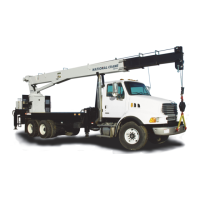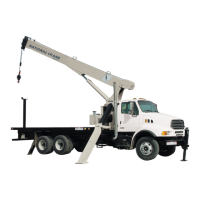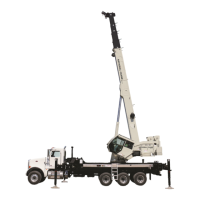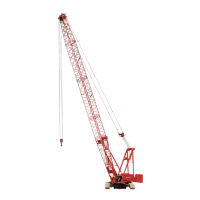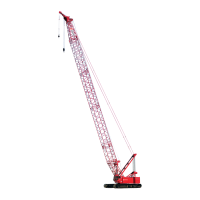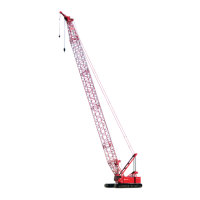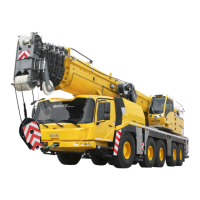OPERATING CONTROLS 1400H OPERATOR AND SERVICE MANUAL
2-2 Published 10-30-2014 Control # 040-09
Control Functions
Turn – Operate the lever to RIGHT to rotate the boom in
a clockwise direction. Operate the lever to LEFT to rotate the
boom in a counterclockwise direction as viewed from the top
of the crane.
Swing Speed Adjustment – Located on turn motor
inside frame. Turn knob in to increase maximum swing
speed. Turn knob out to decrease maximum swing speed.
Boom – Operate the lever to DOWN to lower the boom.
Operate the lever to UP to raise the boom.
Boom Telescope – Operate the lever to OUT to extend
the boom. Operate the lever to IN to retract the boom.
Hoist – Operate the lever to DOWN to payout and lower
the loadline. Operate the lever to UP to reel in and raise the
loadline. Refer to Hoist system operation section for
additional information.
Payout loadline before extending boom. Failure to
do so may cause the loadline to break or damage the
crane.
Stabilizers – Up/Down – Operate the lever to UP to
raise the stabilizer legs. Operate the lever to DOWN to lower
the stabilizer legs.
Stabilizers – In/Out – Operate the lever to OUT to move
beams out and to IN to move beams in.
Outriggers – Up/Down – Operate the lever to UP to
raise the outrigger legs. Operate the lever to DOWN to lower
the outrigger legs.
Outriggers – In/Out – Operate the lever to OUT to
move beams out and to IN to move beams in.
Outrigger/Stabilizer Selector – Use in conjunction with
stabilizer and outrigger controls to select which cylinders are
operational (left side, right side or both). Move switch to the
LEFT position to operate only the left side stabilizer and
outrigger cylinders. Move switch to RIGHT position to
operate only the right side stabilizer and outrigger cylinders.
When switch is in middle position, BOTH, the stabilizer and
outrigger cylinders on both sides will operate when control
levers are activated.
Foot Throttle – Depress the foot throttle to accelerate
the truck engine speed. Release to return to idle speed.
Increasing truck speed increases operating speed.
Emergency Stop Switch – Operate the switch to kill the
truck engine under emergency conditions. Switch must be
reset to on to operate truck from cab.
Horn – Operate horn button to warn fellow workers on
construction site of pending Observe pressure gauge while
booming up or down at end of stroke to determine system
pressure. Note: RCL required on cranes with jibs and/or
man baskets.
RCL Display Console – Acts as interface between
operation and load moment system. It's used to import
operating conditions and display boom and load information.
Refer to RCL manual in this owners manual.
RCL CPU – Processes load information to give operator
crane capacities and boom information. Refer to RCL
manual
in this owners manual.
Capaci
ty Chart – This chart shows capacities of crane at
various operating areas and hoist capacities with appropriate
reeving.
Boom Angle Indicator – Located on either side of the base
boom section and used to determine main boom angle with
respect to horizontal. For reference only.
Boom Length Indicator – Located on either side of the
second boom section. The letters on the intermediate boom
lengths correspond to the letters on the capacity chart. The
length indicators are used to define boom length and with the
capacity chart and load radius are used to determine the
maximum loads that may be safely lifted. Actual radius must
be measured from the centerline of rotation.
Load Radius – Horizontal distance from the center line of
rotation of the swing bearing to the center of the loadline with
the load suspended. Use boom angle and boom length as a
reference to determine loadline or load radius. When lifting
maximum rated load, always know the weight of the load and
measure the radius with the load suspended.
Cold Weather Operation
The following recommendations are for operating National
cranes in very low (i.e., sub-zero) temperatures.
Cranes should have appropriate hydraulic oil, lubricants, and
other auxiliary items required for operation in sub-zero
temperatures. Operate individual crane functions to ensure
they are sufficiently warmed prior to performing a lift.
Operation of cranes at full rated capacities in temperatures
between -9°C (15°F) and -40°C (-40°F) or lower should be
accomplished only by competent operators who possess the
skill, experience, and dexterity to ensure smooth operation.
Shock loading shall be avoided.
Operation Below -40°C
For crane operation below -40°C, capacities shall be derated
3.67 percent of the rated load shown on the capacity charts
for each degree below -40°C.
Operation Below -40°F
For crane operation below -40°F, capacities shall be derated
2 percent of the rated load shown on the capacity charts for
each degree below -40°F.
CRANE WARM-UP PROCEDURES
The following procedures detail the actions that must be
taken to properly warm the different crane components
before operating the crane.
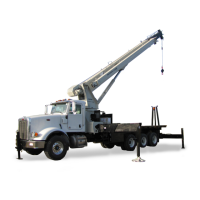
